#Tank Integrity Monitoring
Explore tagged Tumblr posts
Text
Industrial Tank Crack Scanning Standards and Regulations
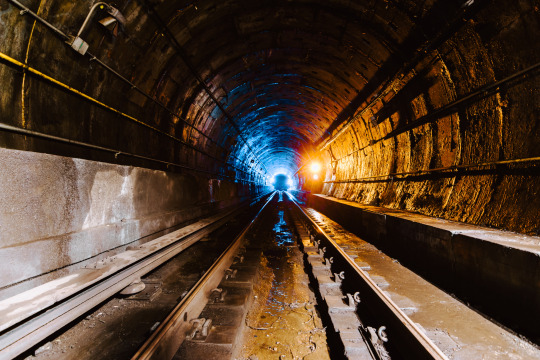
Crack scanning plays a crucial role in ensuring the structural integrity of industrial tanks, especially in sectors like manufacturing, petrochemical, and energy. As tanks are subjected to constant stress, fatigue, and environmental conditions, they are vulnerable to cracks that can compromise safety and functionality. Adhering to crack scanning standards and regulations is essential for maintaining tank safety, efficiency, and compliance.
Crack Testing Inspection procedures are critical in detecting structural flaws that may lead to potential leaks, ruptures, or tank failure. Modern crack detection technologies utilize Non-Destructive Testing (NDT) methods, offering a reliable and accurate way to assess the condition of industrial tanks without causing any damage. Common crack detection methods for tanks include ultrasonic testing, radiography, and eddy current testing. These techniques help pinpoint cracks early, preventing costly repairs and hazardous situations.
The Tank inspection regulations vary by region and industry, but they generally require regular inspections and testing to ensure the tank's compliance with safety and quality standards. Tank scanning technology has advanced significantly, allowing inspectors to conduct thorough checks on tank walls, bottoms, and joints with precision. It’s important to follow tank integrity testing standards to ensure the inspection results are reliable and actionable.
Tank inspection codes and regulations govern the frequency and scope of inspections. Compliance with these codes ensures industrial tank maintenance regulations are met, which include periodic inspections and maintenance to identify and address any signs of deterioration. In addition, tank structural integrity regulations guide the necessary checks and assessments for tanks to remain operational without posing a risk to workers or the environment.
Tank monitoring and inspections are vital for ongoing safety and operational efficiency. Implementing tank integrity monitoring systems and adhering to crack scanning industry standards allows industries to avoid unexpected failures and ensure long-term durability. Using qualified vessel crack test inspection services helps ensure accurate results and compliance with tank maintenance and regulations.
For reliable and efficient industrial tank crack scanning, trust Bioscan LTD to offer top-tier tank inspection services and compliance with all relevant inspection requirements for industrial tanks.
#Industrial Tank Inspection#Crack Detection#Non-Destructive Testing (NDT)#Tank Crack Scanning#Tank Integrity Monitoring#Crack Test Inspection#Tank Inspection Regulations#Tank Maintenance Standards#Crack Detection Methods#Industrial Tank Maintenance
1 note
·
View note
Text
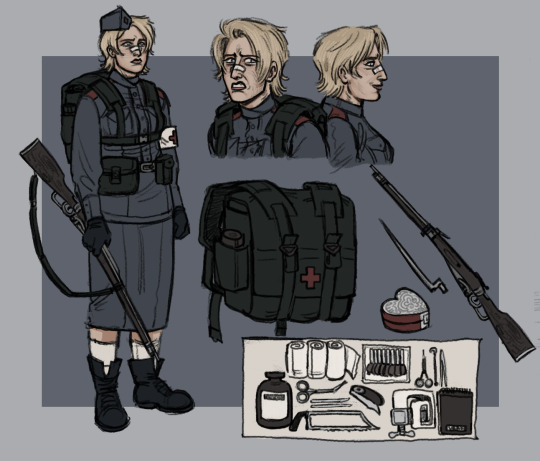
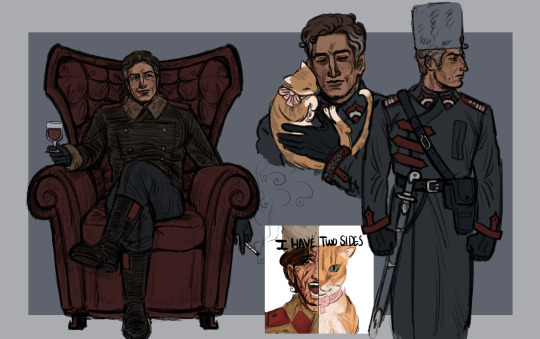
2 more OC reference sheets for myself hehehe and I thought it’d be funny to duo them since these 2 characters HATE each other. This project is gonna take forever but I might as well commit. These are a lot a less detailed than Tra’s. Details & old art below :3 vvvvv
1. Ivanya “Vanya” Shpaga, born July 15th 1890. A young volunteer enlisted woman, once a nursing assistant as a civilian now trained as a field medic for the Grand Field Army. Vanya comes from a lucrative background, her lineage being full of high ranking officials. Particularly her father was an infamous foreign affair diplomat named Artem Shpaga. A man blamed and tried for treason for the invasion of Arayn that reignited the war.
Her initial goal was to remain in hospital tents and behind the line, being entirely pacifist due to her own morals and aspiration to be a surgeon. She never had any intentions of transferring to a combat unit until she met Major Tra. After a brief period of time being the assigned medic to monitor Tra’s recovery and release, she was transferred by personal request to the Field Army 1st Tank Battalion.
2. Sergei “Grand Field Marshal” Novikoff, Born December 31st 1875. The middle child of the Novikoff family and The Grand Field Army Marshal. Sergei is the highest official and the main representative of the Field Army, both famous and infamous for his heavy personal involvement within the army. Known for being well informed, involved, and incredibly forward thinking, being a very competent leader is an agreed upon fact by most officers and enlisted soldiers alike. At the same time he is known for his explosive tendencies, lack of integrity, alcoholism, and hubris. + In the past he was rumored to be a conspire with Artem Shpaga, but it was largely dismissed after the “trial and sentencing”.
Sergei is also the adoptive father of Major Tra Volkonov. Tra and her brother Zsombor were taken in by the Novikoff family as an act of devotion to Sergei’s decision to flat out ban the use of child soldiers in the Field Army following an incident. Though largely questioned, he is thought of very highly for raising the magisterial woman that is Major Tra. Many cracks and leaks spawned by Sergei are often swept under the rug like this, leading to him never being truly held accountable for anything.
(Jumpscare REALLY old art)






#Sergei and Tra do NOT get along either Lol#it’s mostly one sided on Tra’s part Sergei still tries#he truly believes he is a father#3 characters down maybe like….15 more to go#uhhhhh#silnaarttag#my ocs <3#oc artist#oc artwork#non fandom oc#character illustration#oc reference#Vanya schpaga#Sergei Novikoff#traditional art
33 notes
·
View notes
Note
What’s the longest dive you have ever needed to complete for a rescue, and how did you handle fatigue and mental focus? It’s got to be incredibly difficult to have a complicated rescue that requires continued attention.
Ooh, big question (a very good one, thanks!)
I’ve done quite a few long trips that have meant staying at depth for a couple of weeks here and there, research trips and obviously back when I served with the WASPs. Not for an immediate rescue though as part of iR - It’s very different when it’s a rescue.
The longest rescue dive I’ve ever done in one stint was nineteen hours. That’s the record for me (and not one I’m eager to beat). It was off the Mariana Ridge. A deep-sea pipeline maintenance station had a catastrophic collapse - pressure door failure, electrical fire, you name it. There were six workers trapped in a reinforced chamber, two hundred metres below the surface. Scrubbers that were failing, a hull that critical - it was a race against time and physics.
The dive was brutal. Currents were wicked strong, the seabed was shifting, the structure was collapsing and the visibility was almost zero. I had to alternate between piloting Thunderbird 4 through a collapsed support grid and EVA’ing to try and stabilise the structure and make us room to get close. Absolutely no room for error. One wrong move and the entire thing could’ve gone down.
And here’s the thing most people don’t realize — it’s not just the currents, or the pressure, or the sheer isolation that wears you down. It’s the constant vigilance. For eighteen hours, I couldn’t mentally look away. Every second I was calculating: gas reserves, structural stress, movement patterns, pressure calculations, body positioning, welding and cutting. When you’re diving that deep, with that kind of responsibility on your shoulders, you’re always working. There’s no coast mode.
It’s the mental grind that really tries to get you. You’re thinking about how to gently cut through a collapsed bulkhead without triggering a chain reaction. What is going to happen if I release this valve? How is the pressure going to shift? What else has failed on that panel that I can see - is there a weak spot I’m not anticipating? How injured are the crew? Am I going to be able to stabilise them before they need to hit the surface? What am I going to do if I get inside this thing and someone’s too sick for that? How am I getting us all out if my entryway is blocked, what’s my plan B, C, D?
Because you’re always thinking about the voices on the other end of your comms - scared, breathing too fast, trying to believe someone’s coming. They don’t need to know how complicated it is on your side - they just need to know you’re coming for them.
I used very short windows back in Four, still at pressure, to do breathing drills - stretch, re-center myself, run diagnostics. It helps keep a clear head.
I manage fatigue the same way I manage everything else down there — through systems and rhythm. My suit is obviously pressure and temp controlled automatically. Four runs my monitoring remotely, but I hooked up to the umbilical for outside EVA’ing for that length of time. Saved swapping tanks, and it meant she could continue to adjust my gases for me as I worked, constantly judging my nitrogen levels for a mix of Tri and Hydrox. Takes some of the brain work away for me, and I trust her (and Brains’ engineering) without fault. I have an integrated hydration system (like a squid-friendly Camelback) so I have electrolyte fluids going (it’s just fancy Gatorade 😏). High-calorie, fast-absorbing nutrient gels every couple of hours. Caffeine tabs when I felt myself slipping.
I had my favourite playlist running low in one ear. Mostly instrumental stuff. Nothing that demanded too much brain space. And of course, John’s chatter about systems in the moments that didn’t require that intense, silent focus, and Virgil’s absolutely terrible ocean themed puns. And this is why they’re so damn excellent at what they do - John knows when to stay quiet or when to chime in with a report back on something, and Virgil just knows me in the field like nobody else, I don’t have to explain everything, he anticipates it.
Scott, on the other hand, was actually blocked from comms at one point because I was sick of hearing my own name and having to reply every five minutes because he was convinced I was dead. He was somewhere between strangling me and having kittens by the time I re-surfaced, I think it may have been more peaceful under the water 😏
The actual extraction took nearly six hours. Had to flush one of the pipelines and use it as my way in which was… yeah, until I’d actually got into it and made sure it was totally clear of the gas, I was sweating, won’t lie. It was pitch black, only had my headlight and (look away now if you’re claustrophobic) tight enough that it was a bit of a wiggle at the bends, shoulder to shoulder touching kind of stuff. Really, navigating through it by touch and feel, before there wasn’t enough space to turn my bed properly or lift my arms.
Once I was inside, I stabilised all of the crew and then one by one, guided each of the guys back out through that pipeline. That was tough. Most of them were injured, all of them were cold and hypoxic, and (again, claustrophobics of the world, shield your eyes), being dragged backwards through a flooded pipeline in the dark, unable to lift your arms and with the wall just inches off your nose is terrifying. Took a lot of my signature chatter to get us all through that one.
But each safe rescue is an adrenaline boost - you move with the wins, however small or big they are. Break it down into steps. It keeps you going. Each crewmember safe in the back of Four was a huge push to carry on, despite the fatigue and exhaustion and discomfort. And in the end, the massive satisfaction of a job well done when there’s six men returned safely to their families.
And I was exhausted 😂 I slept off my decomp after I’d got the crew to the surface. Sound asleep in my kit on the floor in the back of Four. 11/10, best sleep of my life. Virgil gave me a piggyback to the medbay once I hit the top and let me go back to sleep 😂
Once again, Scott thought I was dead. I was, in fact, alive and well- as my suit reported, but why allow fact to get in the way of a good smotherhenning? 😏 I fell asleep on one of the loungers by the pool and I swear he was on patrol to make sure I was still breathing.
#excellent question!#thanks anon#thunderbirds rp#thundersocials#gordons squid thoughts#tw claustrophobia
16 notes
·
View notes
Text
Covenants and other Provisions
Chapter 49
Impression
Today marked the third consecutive day of testing.
Ford hunched over the small glass containment chamber, the stiff curve of his shoulders silhouetted by the glare of the overhead halogen. His breath fogged faintly against the inside of his protective goggles, and a medical mask clung damp over his nose and mouth—flattened from long hours without speech.
Inside the chamber, nestled on a square of sterilized gauze, lay the object—the egg.
Its surface had changed again. Since the excavation, it had darkened—shifting from its original pearl-gray translucence to a deeper, richer slate. Iridescent patterns now fanned across its shell in branching fractals.
Ford leaned in closer, elbows braced on the edge of the table. He watched it intently, eyes tracking each curve, each glint. Every line recorded itself in the back of his mind.
“You’re positive it’s incubating?” Bill’s voice pressed gently against the inside of his skull.
“Has to be,” Ford murmured. He didn’t blink. “It’s generating internal heat. And this”—he gestured toward the shell with the tip of a capped pen—“this pattern wasn’t visible yesterday. It’s changing. Constantly.”
Bill hummed thoughtfully—a low, ghostly vibration that pulsed between Ford’s temples. “Cellular differentiation? Or are we looking at a metabolic ramp-up?”
Ford straightened with a faint crackle of his spine. He peeled off one glove and flexed his fingers, trying to shake off the ache that had crept into the joints overnight. “Could be both. The color variation might indicate the build-up of metabolic by-products beneath the outer membrane. It’s subtle—but biological. It’s not just reacting. It’s preparing.”
He tilted his head slightly, squinting through the glass. “Look at the condensate forming on the far wall—see that? Light misting. That’s respiration.”
There was a short, appreciative pause. “Nice catch.” Bill sounded pleased—Ford glanced sideways at his own reflection in the tank’s polished surface.
“Thanks,”
Ford picked up his notebook and scribbled a few meticulous lines:
Subject viable. Respiration evident. Internal thermoregulation active. Shell integrity intact. Recommend protocol C-7 for phase monitoring.
He tapped the pen once against the notebook’s spine before setting it down—the ache was subtle, but persistent. A dull throb from tendon to wrist. It had been there all morning. And all the night before.
He rolled his shoulders before glancing back at the egg. The temperature inside the tank had risen another half-degree since sunrise. A sound interrupted his thoughts; A faint crackle.
Subtle—so light it might’ve been static—but Ford heard it. Felt it. His attention focused on the chamber, eyes narrowing behind the goggles.
The surface of the egg shivered, a tremor almost too delicate to register.
“Bill,” he whispered. “It’s happening.”
“I see it,” Bill murmured, his tone shifting—soft, taut with restraint. “Steady, Sixer…”
Ford’s breath slowed beneath the mask, shallow and rhythmic. The room around him seemed to hold its own breath.
Another crack appeared.
Then another.
The fractures spread outward in fine, pale veins—spiderwebbing across the shell until one segment, trembling faintly, began to lift.
A single shard curled away—slow, precise, deliberate. And beneath it: something wet. Something soft. Something moving.
Ford didn’t blink.
The notebook lay forgotten beside him, pen uncapped and idle.
Bill’s presence coalesced—tightening into a pinprick of focus, like a lens narrowing, like the world shrinking to a single point of light. Neither of them spoke as the creature inside began to stir.
Limbs unfurled.
Delicate. Translucent.
Tiny filaments wriggling from a slick, segmented body—glistening under the clinical glare of the halogen lamp. The thing’s head—small, featureless—tilted gently as if calibrating, testing.
It’s face was soft, rounded where features would one day settle—Then it stilled. Oriented. Directly toward Ford’s face.
Ford’s chest rose and fell in shallow pulls. His eyes flicked across its body—cataloguing, noting—until something stilled in him. The creature was larval, no question. The limbs were underdeveloped, twitching more from residual nerve spasms than any coordinated intent. Its skin, if it could be called that, looked like translucent wax stretched too thin over bone.
It wriggled once. Then again. Then curled in on itself, the movement slow and uncertain. A faint, breathy click escaped from within its small frame—For a moment, nothing else moved.
“Well,” Bill said at last, bone-dry. “That was underwhelming.”
“Juvenile stage,” Ford murmured, his voice steady again. The trance was broken, but the awe lingered. “Lacking structural rigidity. Limited motility. Likely incomplete neural development.”
He reached for a small specimen carrier, metal edges gleaming under the lab light. With practiced care, he slid the gauze inside—noticing how little resistance the creature gave. It didn’t flinch. Didn’t react. It simply nestled into the new environment like it belonged there.
“A chrysalis, in essence,” Ford continued. “Early metamorphic phase.”
Bill made a noncommittal sound. “I expected wings.”
“It was underground,” Ford said, “why would it have wings?”
“You never know,” Bill replied. “Evolution’s full of surprises. Could’ve had gills. Or fangs. Or a second ass. Honestly, Fordsy—your lack of imagination is holding science back.”
Ford sealed the carrier, locking the lid with a satisfying snap, then slipped it beneath one of the backup fume hoods, switching on the low hum of the filtration system. He watched the shadows stretch over the curve of the creature’s back—watched it shift faintly, tucking its limbs in tighter.
“You know, cicadas gestate underground and they have wings,” Bill offered cheerfully.
Ford chuckled, shaking his head. “I’ll run a spectral scan later,” he said. “See if its energy signature shifts now that the shell’s gone and try to get a better idea of how it’ll grow. Who knows—maybe it will grow wings.”
Bill brightened. “I knew you’d come around.”
The days that followed passed in a measured lull, the kind that felt deliberate—like time was waiting for something to arrive. Each morning, Ford returned to the containment chamber with fresh gloves, a new surgical mask, a steaming mug of coffee balanced near the edge of the workbench, and Bill curled somewhere behind his eyes.
The larva remained in containment.
It grew quickly—not alarmingly so, but steadily, like a thing following strict internal blueprints. By the 36-hour mark, the beginnings of a face had taken form: two bead-like, reddish eyes set far apart, and a soft, rounded mouth that puckered faintly against the glass.
Ford noted the shift. Sketched it. Compared the curve of the jaw to reference samples from aquatic invertebrates.
Then, around hour 72, something changed.
Without warning or rupture, four sharp pinchers punched through the dermal tissue around the creature’s mouth—wet, precise, like blades through fruit skin. They unfurled slowly, each glistening with clear fluid before twitching once and retracting slightly. A second stage. Or maybe a defense.
Ford didn’t flinch. He noted it down.
Craniofacial development: evolving. Proboscis accompanied by retractable mandibular apparatus. Possibly predatory. Possibly vestigial.
It tolerated the scans. Showed no stress reactions. Vitals: stable. Respiration: shallow but rhythmic. It barely ate—just trace amounts of protein gel, which it absorbed directly through its membrane. No excretion. No digestion. No waste.
Occasionally, It clicked.
Just a faint, wet pop at first. Then again. Then again. The sound began to settle into a rhythm. Not language, exactly. But not random.
And It watched—It never stopped watching.
Even when Ford walked away from the tank, even when his back was turned. Its gaze tracked him.
One morning, during a routine spectrum alignment beside the tank, the creature shifted.
He didn’t catch the movement itself—just the aftermath.
He glanced over—and stopped. The creature was no longer itself. Its body had folded inward, limbs tucked flush against its central mass. Its surface was rounder now. Glossier. The color had adjusted subtly to match the pale enamel of the ceramic mug Ford had left beside the tank.
It was wrong—off by a few degrees. The handle was too wide, the curve too squat. But it was unmistakable. Not random. Not environmental. It had chosen the mug and It wanted to match.
Ford and Bill stared with bated breath.
Ford reached, slowly, for the pen in his lab coat pocket, hand twitching with adrenaline, and began to write.
That same evening, Ford and Fiddleford found themselves in the kitchen at the same time—a rare overlap in their diverging routines. It wasn’t planned. Just a quiet convergence, like two trains briefly sharing a track before peeling off again.
They sat shoulder to shoulder at the counter, elbows brushing faintly as they picked through the ever-simmering hunter’s stew. Fiddleford had long abandoned the idea of variety—he’d taken to chopping up whatever meat and vegetables he could scrounge from the week’s supply run and tossing it into the same pot, never quite letting it empty. He’d ladle some out, add a little water or salt, and keep the base going—a perpetual brine, thick and murky and stubbornly sustaining. An old habit from back home, he’d once said. “Like sourdough,” he’d added. “But soup.”
Ford blew across his spoon. The surface shimmered with grease. Then, casually—as if announcing the weather—he said,
“Shifty was a mug this morning.”
Fiddleford blinked. “…Come again?”
“The larva,” Ford clarified, eyes still on his bowl. “It mimicked the coffee mug I left next to Its enclosure.”
Fidds lowered his spoon, chewing more slowly. “You… named it?”
“That’s just what I’ve started calling him,” Ford said with a shrug, as though trying to sound offhand. His voice was a little too neutral. His eyes didn’t leave the stew.
Fiddleford squinted. “What happened to not getting attached to the specimens?”
“You’ve got Stache,” Ford replied, glancing sideways. “Maybe I want a little lab pet too. Just�� a cooler one.”
“Stache is cool!”
“He’s a common rat.”
“He’s got personality, you just won’t give‘m a chance. Your experiment hardly moves.”
Ford made a low, dismissive grunt, chewing slowly. “It shape-shifted,” he said flatly. “Way cooler than that incessant wheel-squeaking marathoner.”
“He runs because he’s full of energy and ambition,” Fidds shot back, smiling now despite himself. “While your little mutant baby plays tea party.”
They lapsed into silence for a moment, eating again. The warmth between them wasn’t loud, but it was familiar.
Then, Fiddleford exhaled through his nose and lifted another spoonful. “Still… shapeshifting,” he muttered. “Could pose some serious issues down the line. Containment might get tricky if it gets smarter.”
Ford shook his head, still chewing. “He’s tiny and harmless,” he said after swallowing. “But yes—I’m curious about the underlying mechanisms. How the protein lattice reorganizes, how the cellular signaling determines form…”
He trailed off, then added, almost absently:
“If I can decode it—there might be a way to apply it to something more targeted. Controlled molecular phase transitions. Or maybe even biological tunneling. A way to help organic matter stabilize through the gateway without degradation.”
Fiddleford paused mid-bite. “That’s not nothing,” he said, brow furrowing faintly.
Ford nodded. “It’s just a thought.”
Fidds didn’t answer right away. Just took another spoonful, chewing slowly. Then, with a glance toward the sink, he muttered around the bite:
“‘Shifty’ is a dumb name.”
Ford looked up.
“Lacks creativity,” Fiddleford added, stabbing his spoon back into the bowl. “Not your best work, my friend.”
Ford huffed a laugh through his nose.
The next day, Ford and Bill resumed testing.
He slipped on fresh nitrile gloves, cinched a new mask tight across his face, and powered up a fresh battery of responsiveness trials: graduated light pulses, ±6 °C temperature sweeps, and a gentle oscillating electromagnetic field meant to mimic the portal’s fringe resonance.
The larva—Shifty—sat motionless on Its sterile tray. A halo lamp bathed it in white.
For the first twenty minutes Ford simply watched, logging minor dilations in the skin lattice as each stimulus rolled past. No stress response. No tachycardia. Only smooth internal temperature regulation and that unnerving, steady gaze.
OBS: When field oscillates at 42 Hz, dermal tessellation brightens ≈7 %.
HYP: Creature may be syncing to external frequency—possible phase anchor.
He adjusted the field strength and tried again. The patterns brightened further—then bloomed outward, splitting into finer sub-cells like a living diffraction grating.
Inside the chamber, the creature didn’t flinch. Not at first. But It observed. It always observed.
Its head rotated deliberately, not with instinctive jolt but with a mechanical patience—like seaweed curling on an underwater current, slowly reorienting as Ford moved across the room.
Once, when he reached for a beaker, It twitched.
When he turned, It stilled again—perfectly. As though It hadn’t moved at all.
Ford frowned, adjusted the environmental controls by another half-degree, and logged a subtle shift in micro-electrical fluctuations. He didn’t remark on it aloud. Not yet.
Bill’s voice slid in, low and irritable. “I don’t like the way It watches you. Gives me the creeps.”
Ford toggled the environmental control down half a degree. “It’s fine, muse. He’s just curious.” Ford said, his focus hard on the screen in front of him—something in the data didn’t line up.
Same mass. Same volume. But molecular alignment… drifted. Like certain regions of the creature’s body were borrowing from a structure not currently present.
Bill perked up, sensing Ford’s attention sharpening.
“There,” Ford murmured, mostly to himself. “That overlay—see it? The peripheral density is off by—” He checked the scanner. “—eight percent.”
“Mm.” Bill’s voice was velvet. “Like It’s pulling pieces from somewhere else.”
“Or somewhen else,” Ford corrected, adjusting the scanner’s depth. “The molecular cohesion isn’t just shifting, it’s stabilizing. Which means It’s pulling coherent reference templates. Probably nonlocal.”
“It’s mapping the pulse. Building a scaffold.” Bill said.
Ford’s pencil paused. “Or,” he murmured, “It’s pulling mass from out-of-phase harmonics—borrowing subatomic inventory stored in adjacent dimensional pockets to finish the shape.”
That line of thought—borrowing matter to lock form—clicked hard. If Shifty could do that on instinct, a designed bio-matrix might pre-load the missing atomic states before transit. Organic cargo could slip through the gateway and re-cohere on the other side without decohering DNA.
NOTE: Test localized EM scaffold + protein lattice infusion.
Could pre-seed molecular vacancies → maintain continuity through portal jump.
Bill hummed, impressed. “Cross-dimensional imprinting.”
“Exactly. It’s compensating. Pulling biological patterns from parallel planes to maintain structure in this one.” Ford’s voice was breathless now, excitement blooming behind his eyes. “If we can decode how It stabilizes—if It’s embedding dimensional anchors on a cellular level…”
Bill, exhaling in a low purr: “We could send a living thing through the portal without scrambling it.”
The door at the top of the stairs creaked.
“Left my tape measure,” Fiddleford called, boots scuffing each step as he descended, hands rubbing together against the basement chill. He didn’t look up.
Ford sidestepped to clear a path.
Shifty moved again—no twitch this time, but a purposeful pivot. The entire larval torso leaned toward the sound of Fidds’ footfalls with an almost canine interest.
Fidds rifled through a drawer. “Still babysitting?” he asked, sliding a roll of green tape out.
The creature angled further, following him.
Its whole body, previously limp under the glow of the examination lamp, leaned forward just enough to register as intentional.
Ford watched silently.
Fidds didn’t notice. He moved to a drawer, rummaged for a moment, and pulled out a yellow tape measure with one hand. “Still babysitting?” he asked casually, glancing toward the containment chamber.
The creature stared back at him. It didn’t blink. It didn’t break.
Fiddleford’s expression faltered—just slightly.
Ford yawned as he turned away from the tank, lifting his goggles to rub at tired eyes. He summarized the morning’s findings—dimensional borrowing, quantum scaffold, the possibility of stable bio-transit. His words blurred at the edges; he hadn’t slept in days.
Fidds listened, brow knit. Then he pointed past Ford. “It’s going after your journal.”
Ford spun. Shifty’s glossy mass had extended a thin pseudopod, suctioned around the corner of his open notebook, tugging it centimeter by centimeter across the tray.
Ford snatched the book back. “Hey—need that, silly goose,” he laughed. He grabbed the notebook and pulled it free with a slick pop, the pages now damp and tinged with gray at the corners.
The creature made a soft, disappointed click.
Fidds clicked his teeth. “Well, don’t let me interrupt your family time,” he quipped, and turned to head back upstairs.
Ford remained by the workbench for a long moment. He rested his hand lightly atop the closed journal. Shifty had resumed its stillness—but Its attention never left him.
He blinked slowly. The ache behind his eyes was back. He’d been awake for nearly forty-eight hours.
Silence settled. Ford rested a hand on the closed journal; the creature resumed its statuesque stillness.
The ache behind his eyes returned—stacking against the hours he’d been awake.
Bill—already rearranging the dreamscape’s furniture, selecting colors that matched and where to place the lighting—coiled warm and persuasive at the edge of consciousness.
“Come on, genius,” he whispered, silk and static. “Close your eyes for a little while. I’ve got something to show you.”
Ford exhaled through his nose—slow, shaky.
He powered down the station. Dimmed the halo lamp. Reached for the transfer tray and gently lifted Shifty back into his primary tank.
The creature didn’t resist.
Ford sealed the lid. Latched it shut.
Then crossed the room, his footsteps slow and deliberate. He sat down. Rested his head against folded arms—Just for a minute.
The hum of the lab’s machines hadn’t changed—same soft alerts, same rhythmic compressor valve—but something in the air had. It wasn’t a sound. It was a texture. A quality.
Something missing. Too quiet around the cage—Ford lifted his head.
The containment unit sat half in shadow—glass streaked faintly, as if something had touched it from the inside. The lid was shut. The latches still locked. But inside, there was nothing.
The tray was empty.
A slow, viscous pressure slipped down Ford’s spine. He didn’t move. Not yet. He just let his eyes adjust, scanning the dark corners of the lab where light fell off. The monitors blinked their usual soft alerts. No emergency. No security trip.
The test samples were where he’d left them—uncapped, but untouched. No signs of force. No containment breach.
And yet—
A cold rush swept behind Ford’s eyes—a ripple of static across the ribcage, like something breathing with him, but just slightly out of sync. His pulse stuttered—then recalibrated.
“That’s no good, Six.” Bill’s voice curled in quiet and taut.
Ford stood without a sound.
The stairs creaked underfoot, but even that felt off—like the wood didn’t recognize him anymore. The house had grown unfamiliar. Or maybe just uncertain. Like it hadn’t decided yet whether to protect him.
A single light burned in the kitchen—over the sink. It cast a long oval of amber across the floorboards—someone stood at the counter; Back turned. Shoulders slouched. Pouring coffee into a mug: Fiddleford.
Ford froze mid-step. Not out of hesitation—out of command. His limbs locked in place. Bill moved inside him like a muscle tensing, coiling tight around the spine. Their shared pulse narrowed to a thread.
“Didn’t hear you come up,” Fidds said.
Ford’s breath filtered through his nose, shallow. He didn’t answer. The voice was off. Not in pitch—but in cadence.
Ford’s eyes flicked toward the coffee pot—off. The clock near the fridge read 11:30pm—Fiddleford hated stale coffee. But he lifted the mug to his lips, leaving space for thought between each motion—a sequence learned, not lived.
Another shift from Bill, deeper now. Ford felt it in his throat, in his jaw, in the bite of his molars as his back teeth ground slightly together.
A silent message, clear as glass:
That’s not him.
“You’ve got your journal, right?” the thing asked—just a little too brightly. “Been hoping to read through some of your notes.”
Ford’s eyes didn’t move. Only the smallest tilt of his head. He registered the twitch in the left hand lifting the mug—too deliberate. The angle of the jaw—just a few degrees off.
His own voice emerged quiet. Controlled. “Not here. It’s still in the lab.”
“Mind grabbing it for me?”
A slow current tugged at Ford’s muscles—Bill’s pulse thumped inside his own, two intentions braided together. “Come with me,” Ford offered, voice level, almost cordial. “I can walk you through the section on cellular mimicry.”
The thing hesitated—just a fractional stutter—but then it nodded.
Ford pivoted and started for the stairwell. Every stride felt too long, stretched thin with the weight of calculation.
Behind him the footsteps resumed, perfectly spaced—exactly spaced, like beats looped on tape.
Bill slid back into Ford’s rib cage, a crawl of static under the skin. The warning wasn’t a word; it was the burn in Ford’s palms, the faint catch in his left heel.
Don’t let It get behind you.
At the hall threshold Ford brushed his fingertips against the doorframe—an old superstition, grounding—then angled sideways with polite deference, one arm sweeping toward the stairs.
“After you.”
The not-Fiddleford paused at the top step, head tilting.
“You sure you didn’t leave it up here?” The cadence was warm, casual—too casual, vowels shaved perfectly smooth.
Ford met its gaze. “I didn’t,” he said. His tone carried no room for debate. Then, softer, coaxing: “Come on, Fid. I want to show you the results from yesterday’s calibration test.”
For a breath the creature’s eyes flicked in tight arcs—between Ford, the dark well of the stairway, and back—triangulating vectors, measuring angles, calculating risk.
A tendon jumped in Its jaw.
Bill’s presence wrapped tighter, ready to drop the tether between thought and muscle. Easy… keep It moving, he murmured.
Ford held the thing’s gaze, steady, unblinking.
Its head twitched—subtle, stuttering, a splice of movement out of sync with everything that came before. The smile faltered. The mask thinned.
It made a sound.
Soft at first. A breath. Then a guttural click, wet and echoing, as though someone had cracked a knuckle inside Its throat. A trill rose beneath it, rounded, insect-like, and faded as quickly as it came. The mug trembled in his grip, handle tilting with the torque of something shifting inside.
Its gaze broke from Ford and flicked downward—into the stairwell, toward containment.
Then It shifted sideways—just a glance—but Ford followed it immediately. The back door, ten feet away—freedom.
Bill revved Ford’s nervous system—a static bloom that raised the hairs on his arms.
Then, It detonated into motion—shoulder dropped, mug hurled in a spinning arc.
Instinct fired: brace —Ford tucked his chin and raised his arms as ceramic burst against the jamb, shards hissing past his ear. A burst of old bitterness hit the air. The creature barreled into him.
Momentum pitched them both backward—Ford’s heel slipped on the top step—gravity yawned—then Bill locked his joints, a steel rod through spine and calves. They jolted short of tumbling, boots rasping wood, his arms snapping out and catching himself on either side of the doorframe.
The creature was already twisting off him, one arm swinging wide to pivot—lunging for the door.
In the dim light, the creature’s face spasmed—Fiddleford’s features half-melting, reforming into something blank with rage. It hissed again, that insectile click, and twisted hard—
—but Ford and Bill were already adjusting. Each motion was purposeful, charged. Eyes tracked. Hands flexed: Don’t let It out.
Ford’s body hurled down—hands smacking the tile, the balls of his feet and the heels of his palms planting galway—then vaulting toward the creature already halfway across the kitchen.
Ford’s vision blurred with motion. Bill lit up.
The creature reached the door—hand grazing the latch. And they hit It mid-stride. A low, brutal impact. Shoulder to ribs. Full-body tackle. Bone on meat.
Bill conducted Ford’s grip—
Left forearm: under the neck.
Right hand: seize Its wrist.
Knee: wedge.
Body: down.
Ford slammed It into the floor.
It bucked—hips snapping like a fish on deck, spine liquid under Ford’s pin. His fingers slipped; Its skin was slick—sweat, mucus, something worse. The wrist tore free and It rolled, sweeping Ford’s legs with a whip-fast scissor.
Before Ford could right himself, It was moving—hugging the floor like a stain. It reversed direction mid-lunge, hooking Ford’s ankle, then yanked. Ford’s torso twisted, elbow driving down, but he only caught empty air; the creature—far stronger than expected, flung him across the room.
Ford saw only motion blur and then felt the slam of the pantry door exploding off its hinges and splintering as he crashed through it. Dry goods fountained onto the floor: rice, lentils, a flurry of alphabet pasta geysering into the hair, raining a beige confetti that pinged like hail.
Get up, Ford
Pain bloomed bright along his ribs, but Bill flooded the muscles with borrowed steadiness. They rose in a single, joint motion.
Through a haze of flour dust he saw it: a grotesque splice of Fiddleford’s silhouette and gelatinous anatomy—jaw melting, limbs elongating, joints popping to new angles mid-stride. Already reaching the latch again.
Ford’s pulse narrowed to a pinpoint. Bill tightened the coil along his spine. Think fast
Ford grabbed the half-empty flour bag at his feet and hurled it. It burst against the back of the creature’s head—a soft white detonation, a guttural snarl—visibility gone. The flour billowed outward, obscuring everything in a thick, blinding cloud.
Ford dove through it.
Hooked with his right, his knuckles connecting with something soft and unstable—like punching into wet sand. The creature’s face caved, re-inflated, eyes skittering beneath the skin. Bill utilized the momentary disorientation and snapped Ford’s arm around Its neck, locking It into a choke hold.
It hissed—sound modulating through three pitches at once—a mess of legs skittering across the linoleum floor, moving through rooms as both bodies fought for control.
A lamp went over as their feet hit the cord, ripping it from the wall, sparks popping like fireflies.
They crashed through the glass end table—
Glass crunched beneath Ford’s palms as he dragged himself upright, one arm slung tight across his ribs. Every breath razored hot along the fracture-line—but Bill kept the pain at arm’s length, flooding sinew with borrowed adrenaline.
Across the wreckage the creature straightened too.
It had shifted, now wearing Ford’s body.
Same height. Same rangy shoulders. The unruly sweep of hair pushed back from the brow. But the details betrayed It: shoulders sloped a shade too low; eyes a fraction too large, the sclera tinted bruise-mauve; a copy of Ford’s half-grimace hanging slack, as if the muscles hadn’t been told what tension meant.
Bill sniffed inside Ford’s skull—sharp, disdainful. “Well that’s just insulting.”
It lurched forward—Ford met It halfway.
He struck first—a short, vicious elbow slamming beneath its jawline. Cartilage crunched; the skin folded like damp paper. Before the creature could rebound, Ford fisted the collar of Its borrowed flannel—felt the fabric liquefy in his grip, half-cloth, half-gel—and twisted hard, using the torque of his torso to pivot.
Ford drove forward. They crashed through the kitchen entryway, boots skidding over spilled rice and shards of wood. The creature staggered but caught balance with an inhuman whip of Its spine—vertebrae rippling beneath the plaid like beads on a string.
It struck—a mirror of Ford’s own hook—but the angle skewed, momentum off by a hair. Ford slid inside the arc, raised both forearms to jam the blow, then hammered a knee into Its abdomen. The copy’s torso caved like sandbag, then inflated again, organs sloshing beneath the guise of muscle.
“Your form’s sloppy, Sixer,” Bill taunted, earning a laugh through Ford’s teeth—part courage, part provocation.
The copy shrieked—Ford’s own voice bent backward, layered with that same wet, clicking trill. Then It lunged.
Claws bloomed where fingers had been—wet blossoms of keratin unfurling like sea creature spines.
Ford ducked, powered off his back foot, and hip-checked the thing into the counter. Drawers rattled; knives clattered like wind chimes.
He snatched a chef’s blade, reversed the grip, drove it into the copy’s thigh. The steel slid slow—not like meat, more like pushing through damp plaster. The edge stuck, dragged, caught on something.
The creature wailed, face warping like steam behind glass. It clawed at the hilt, trying to wrench the blade free.
Stairs
Bill jammed the command through Ford’s limbs. Ford caught the creature’s throat, then shoved off the cabinetry, driving both of them through the basement doorway.
Halfway down, they smashed into the railing; the banister snapped, sending balusters clattering. The shapeshifter writhed, momentum lost—Ford and Bill seized It—a forearm choke cinched under its chin while the opposite hand clawed for leverage on whatever texture its skin offered.
They crashed onto the concrete floor of the lab—Ford, his grip tight at the back of the creature’s neck, used It to break the brunt of the fall—but his body kept moving.
The shapeshifter scrambled too, limbs skittering for traction, both of them dragging themselves toward the same destination: the cluttered edge of the nearest workbench.
It got there first.
Ford’s hand slammed down an instant later—fingers closing around cold steel. The prototype electrical wand—unfinished, unstable, but live.
Electricity burst through its midsection. The thing shrieked, stumbling back in a smoking recoil.
Ford surged to his feet.
They circled—both panting, twitching, charged. The creature’s skin shimmered in broken mirrors of him, stuttering through half-held features.
Ford jabbed.
It parried.
Ford feinted—swung again and drove the wand into the creature’s flank.
Forty thousand amps cleaved the air. Blue-white blossom filled the lab, outlines shivering in stroboscopic freeze-frames.
The shapeshifter convulsed—and split.
Ford’s face liquefied down the middle, receding into a slick, dark lattice. Limbs elongated; joints rotated; skin blistered open into plated segments that refracted light like oil on water. Spines erupted along a newly lengthened back. The thing hit the floor on four angular legs, twice Ford’s height at the shoulder, eyes forming and unforming in pits of shifting pigment.
Its roar was broadband.
Now
Steel scraped concrete as Ford swung a lab stool overhead and hurled it like a discus.
The seat pancaked against the creature’s newly armored flank—GONG—drawing every freshly-minted eye his way.
It charged.
Ford back-pedaled in a tight, deliberate sprint, lungs searing, every tendon singing with Bill’s borrowed voltage. Behind him the cryochamber stood open—liquid-nitrogen boil-off curling from the gasket in ghostly feathers of frost.
Two steps from the threshold Bill yanked their balance hard left.
Ford planted, pivoted.
The creature—momentum locked in—shot past him and straight into the chamber’s throat.
Crash—clang—
Ford slammed the door, palm slapping the sealing bar. Mag-locks thudded home; a blue diode snapped from standby to armed.
Nitrogen fog burst across the viewport as the chamber dumped its reserve. Inside, the beast hammered once—twice—talons gouging steel. Then the temperature hit -180 °C.
Plates splintered like shale in a hard freeze. Spines frosted white. Eyes dimmed, glassing over in sheets of ice. Another blow never came; joints seized mid-arc, a roar frozen on half-formed lips.
Twenty seconds.
That was all.
What remained was a crystalline silhouette—a nightmare caught in salt glass, preserved in swirling vapor.
Silence swelled, broken only by the chamber’s compressors and the distant clatter of a loose fan blade.
Ford’s shoulders sagged. Bill’s presence loosened in equal measure, ebbing from battle-rigid intensity to a low, warm thrum—satisfaction, maybe pride.
Ford stood in the center of the wreckage—heart still galloping, adrenaline burning holes in his lungs. Bill was a low thrum across his nerves, watching through his eyes, silent but coiled.
Bang. A dull thud came from somewhere behind him. Ford flinched, spinning toward the sound.
Then another. Harder—followed by a sound. A grunt. Strangled. Guttural. Human.
Ford’s blood turned to ice. Two strides and he was at the tall, dented wall-locker. He tore the handle sideways. The door shrieked open. Inside—crumpled, blood-spotted, blinking against the fluorescent glare—was Fiddleford.
His body was crumpled, arms crushed to his chest, wrists cinched in cable wire, the sheath digging deep enough to leave grooves. A strip of duct tape was plastered across his mouth, curled slightly at the edge from sweat. Dried blood spider-webbed across his collar where the wire had chafed skin.
“Fuck—”
Ford dropped to his knees. He peeled the tape back in one motion—the sound wet and papery, like a sticker pulled from damp wood. Fiddleford gasped, mouth stretching around a jagged inhale—then doubled over, coughing hard until spit and grainy dust splattered the concrete.
“Hey, you’re okay—” Ford muttered, gripping the knotted wires, copper cable biting into his palm as he pulled. It came loose in segments, slipping away inch by inch.
Fiddleford collapsed forward. Freed arms twitched, then reached—one gripping Ford’s sleeve in a desperate clutch, the other pushing him away, weak but reflexive. Wary. Defensive. Almost angry.
When he finally managed words, they came out raw:
“How do I know it’s really you?”
“You cry every time you hear the national anthem.”
“Fuck you,” Fidds wheezed. He sagged, eyes wide, tracking the frozen behemoth inside the cryochamber, then the wrecked lab, then Ford.
Ford eased Fidds down, sitting him against a cabinet, one palm pressed lightly to his friend’s sternum to feel the rise and fall of real breath.
Above them, the cryochamber compressors droned; cold mist spilled beneath the hatch in slow waves, curling around shattered glass and spilled rice. The monster inside remained rigid—a snarling sculpture caught mid-escape, crystalizing in place as frost crept along every segment.
[Previous Chapter][Next Chapter]
[Read Entire Work Here]
[Theres a Playlist, too ¨̮]
#billford#bill cipher#stanford pines#gravity falls#covenants and other provisions#ford pines#billford fanfic#my writing#fiddleford mcgucket
8 notes
·
View notes
Note
consider: akello geeking out with an aquarium enthusiast mc over planted fish tanks and ponds
This is a dangerous slope for him to teeter on the edge of because aquarium maintenance has just as many if not more variables for him to monitor, adjust, and analyze. Please expect not only daily updates via text but quarterly debriefs with intense data analysis and further reporting on species behavior, integration with other specimens in the tank, prime environmental conditions, feasible enrichment opportunities. Also he's named everything in there and is currently writing a script that can ID and track each animal via gopro and hopefully set up a live feed he can watch from his phone remotely.
#jokes on you you get a man w hyperfixation issues and a Why Not Improve attitude#hes gonna overengineer your fish tank sorry#thank you for asking#akello
12 notes
·
View notes
Text
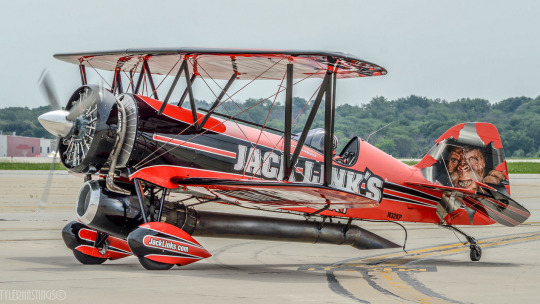
"The Screamin' Sasquatch" Jet WACO
The Screamin’ Sasquatch is one of a kind on the air show circuit John Klatt Airshows and Jack Link’s Beef Jerky teamed up to create a one of a kind plane, the Screamin Sasquatch., which is powered by two different engines. The plane style is a Jet Waco, first introduced by Jimmy Franklin in 1999. The Screamin’ Sasquatch is highly modified in many ways. Every control surface has been specifically engineered for the unique aerodynamic forces encountered during high-speed flight. Portions of the aircraft’s structure have been converted from wood and fabric, to carbon fiber. The cockpit has been moved 3 feet aft, in order to accommodate fuel tanks for both 100LL and Jet A fuel. The cockpit is extremely modern and incorporates the MGL Avionics Stratomaster Odyssey touch screen system, which integrates all of the engine monitoring of both power plants and the aircraft’s avionics systems – essentially combining a couple of dozen gauges into one screen. The Screamin’ Sasquatch, Jack Link’s Jet Waco is powered by dual power plants: a Pratt & Whitney 985 Radial Engine and a General Electric CJ610 (J85) Jet Engine with 3,000lbs of thrust. This system allows the plane to achieve feats other stunt planes are unable to do. The plane will be at a thrust ratio of 1 to 1, which allows it to accelerate going straight up.
#WACO#Jet Waco#Taperwing#Screamin’ Sasquatch#Unique aircraft#Biplane#stunt plane#aerobatic aircraft#one of a kind plane#plane
24 notes
·
View notes
Text
PANDORA EDUCATIONAL OUTPOST: STUDENT ORIENTATION BRIEF
BEA Program | Bureau of Education & Astrobiologica Advancement CONFIDENTIAL: Authorized Student Access Only
ARRIVAL & ENTRY ZONE
Landing Pad & Docking Bay
Primary shuttle drop-off and departure point.
Please remain inside designated zones until cleared by a BEA field officer.
Airlock Tunnel + Decontamination Chambers
You will pass through a double-sealed airlock with air filtration to transition from Pandora’s atmosphere.
Standard post-cryosleep medical checks will be conducted here.
Emergency oxygen masks and airlock re-breach protocols are posted at all entry doors.
BASE LAYOUT OVERVIEW
The BEA Outpost is compact and modular, designed for both safety and immersive study. All areas are connected by the Central Hallway, a reinforced glass corridor that runs through the spine of the facility. You’ll notice local bioluminescent plants growing along the corridor please do not tap the glass.
HOUSING QUARTERS (EAST WING)
Student Dorm Pods
Each student is assigned a private climate controlled pod.
Each unit includes a bed, storage compartment, personal interface terminal, and clear ceiling panels for observing Pandora’s sky.
You are expected to maintain your space. Random inspections occur monthly.
Common Lounge & Cafeteria
Shared zone with seating, holo-screen, vending units, and a communal kitchen.
Please clean up after yourself. remember, this is a long term, small space cohort.
Late night use is permitted but monitored.
Staff Quarters
Located on a separate level. Student entry not permitted unless escorted or cleared.
EDUCATION & RESEARCH WING (SOUTH WING)
Lab Classrooms
You will attend sessions on xeno-biology, botany, exo-ecology, and ethical field research here.
Protective gear is required in sample handling areas.
Tech Bay
For drone deployment, scanning equipment, and technical diagnostics. Handle all devices with care.
Students may sign up for supervised access hours.
Sample Processing Rooms
Clean rooms used for handling flora and biological samples. Entry is limited to cleared students and aides.
Conference Pod
Used for Earth communications, video briefings, and group discussions.
MEDICAL WING (NORTH WING)
Med Bay & Recovery Suite
Two-bed care unit monitored by Dr. Amsel.
Used for cryosleep recovery and minor injuries.
Isolation Unit
Reserved for quarantine or high risk exposure cases.
Medical Storage
Backup suits, oxygen tanks, and emergency kits stored here. Not for student use unless instructed.
OBSERVATION & INTEGRATION WING (WEST WING)
Glass Dome Observation Deck
Open-access deck overlooking the forest canopy. A quiet space for reflection or sketching.
Please avoid leaving food, tools, or shoes in this area.
Cultural Archive Room
Interactive learning center with Na’vi approved media.
Holograms, oral histories, and recorded rituals for approved study only.
Student Aide Alcove (Miles Socorro & Melissa Rivera)
Field notes are logged here. You may be called upon to assist or consult with them regarding etiquette, travel readiness, or interspecies protocol.
UTILITIES & SUPPORT STRUCTURES
Engineering & Mechanics Bay
Staffed by senior engineers. Occasionally used for student support roles.
Home to atmospheric regulation systems and backup generator modules.
Greenhouse Dome
Grows Pandora-compatible and Earth crops. Students may be assigned upkeep tasks.
Water Filtration Hub
Pulls and purifies stream water for base use. Scheduled checks daily.
Air Supply Hub
Check your oxygen canister here every morning before exiting the outpost. Filter replacements are logged.
Security Posts & Satellite Tower
No formal military presence on-site.
Tranquilizer towers are for wildlife deterrent only.
The satellite tower is restricted to senior staff and Earth communication liaisons.
FINAL REMINDERS
No student is permitted to leave the outpost boundaries without authorization, oxygen gear, and a partner.
Always log your movements with the duty officer.
Respect Na’vi territory, customs, and the delicate balance of Eywa’s world.
Curiosity is encouraged. Carelessness is not.
Welcome to Pandora. Let it change you, but don’t try to change it.
(Thinking about doing some OC commentary from the students on this, On a roll. I might do some more )
#pandora#avatar oc#avatar au#avatar frontiers of pandora#avatar fire and ash#navi avatar#avatar pandora#na'vi oc#na'vi#ao3#avatar#na'vi x human#world building#snippet#survival guide#original character#fanfic#fantasy#neteyam sully#neteyam x reader#lo'ak sully#lo'ak te suli tsyeyk'itan#jake sully#neytiri#avatar the way of water#atwow
6 notes
·
View notes
Text
Our Flag Means Death Season 2
The New Zealand Film Commission and Tourism New Zealand partner with Max for season two of Our Flag Means Death to showcase New Zealand to international audiences.
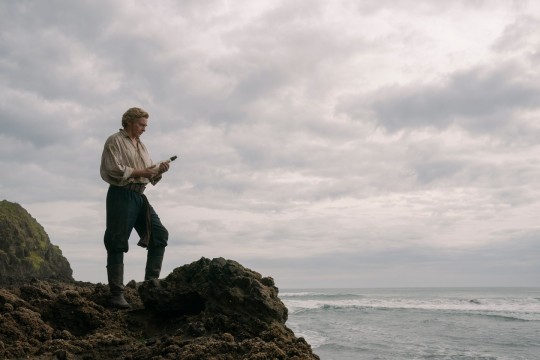
Fast Facts
96% New Zealand crew
78% New Zealand cast
Production based at Kumeu Film Studios
Post-production took place in Auckland
10 New Zealand HODs
67 shoot days
35 sets built
780 Crew
Our Flag Means Death is executive produced by creator-showrunner David Jenkins and Emmy®-nominated star and New Zealander Taika Waititi. In addition to his duties as showrunner, Jenkins directed the first two episodes of season two. Garrett Basch, Dan Halsted, Adam Stein, and Antoine Douaihy also serve as executive producers. Production for the show moved from Los Angeles to New Zealand for its second season.
Our Flag Means Death stars New Zealanders Taika Waititi, Rhys Darby and David Fane, as well as Madeleine Sami (most recently of the Australian mystery-comedy Deadloch) and Samoan-born Anapela Polataivao.
Many of the key creatives and department heads are New Zealanders, including writer Maddie Dai, production designer Ra Vincent, hair and makeup designer Nancy Vincent and art decorator Megan Vertelle. Together, this talented team elevated Our Flag Means Death, contributing their individual expertise to create a visually stunning and emotionally engaging viewing experience. Of the 780 crew contracted onto the show, 350 worked full time.
Creative talent and picturesque landscapes were key motivators for the move Down Under. Showrunner David Jenkins said “We were looking at the season two budget and asking ‘How do you get the most money on screen?’ New Zealand was the answer. I’ve seen more of our budget end up on screen than it did in the U.S. in season one.”
New Zealand also added a breath-taking backdrop to the swashbuckling adventures of the crew. The lush greenery and stunning coastline provided the perfect setting for the 67-day shoot in Auckland at the end of 2022. There were around 50 sets involved, including the 30-acre forest behind the Kumeu Film Studio, Piha Beach, Howick Historical Village and the wild, black sand Bethells Beach.
And there’s one returning figure impossible to miss on the soundstage: The Revenge, the stately ship that Stede Bonnet and Blackbeard (a.k.a. Ed) commandeered at the end of season one. In real life, it was carefully transported across the Pacific Ocean from the show’s original Los Angeles soundstage. The Revenge is approximately 7m x 28m and there were 3x boat sets that were used to create 10 different boats. The production shot in the Dive Tank at Kumeu Film Studios, built a floating market in the Republic of Pirates, and provided storm water effects for The Revenge.
vimeo
Virtual Production
Given that many scenes in Our Flag Means Death take place on the deck of a ship at sea, virtual production was the most practical and cost-effective way of filming.
Virtual production is the process of generating motion picture or computer-generated photorealistic imagery displayed on a dynamically active large scale LED wall to create a ‘virtual’ environment or location on a soundstage.
Surrounding the ship was a giant “volume” wall comprised of 1700 LED monitors displaying a photorealistic ocean background with rolling waves. As a crane-mounted camera weaved around, the images on the digital display moved with it, creating a seamlessly integrated backdrop.
The New Zealand vendors that worked on the screen were NEP Sweetwater, NEP Big Picture, Riggaz with Attitudes, Theatrical Solutions, Xytech and Disguise.
The creative benefit of shooting on the volume wall was that the production could shoot in multiple locations and times of day all within just a few hours. Additionally, the actors could interact with what they are seeing and the lighting shifted in real time.
Careful planning of scenes and shots resulted in the rapid and efficient deployment of a select number of pre-processed moving plates (backgrounds) on set. Paihia, Bay of Islands, Mercer Bay Loop and Waitakere were among the New Zealand locations featured in the plate shots.


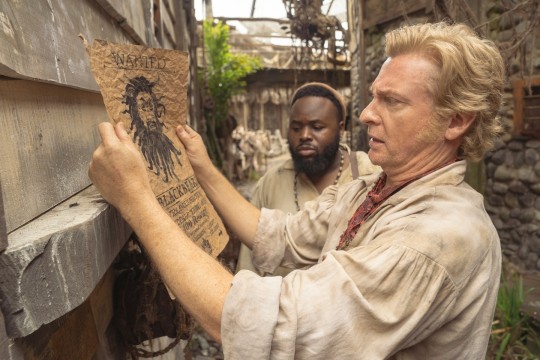
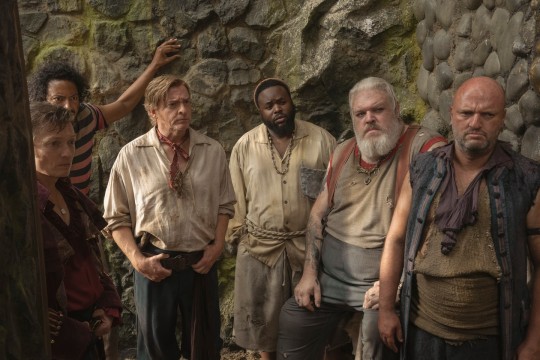

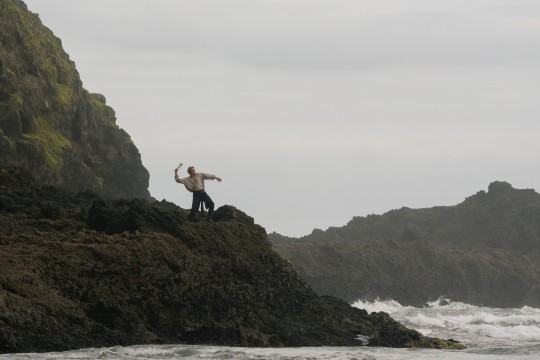

The New Zealand Screen Production Rebate - (International) and 5% Uplift
The New Zealand Film Commission (NZFC) and Tourism New Zealand (TNZ) partnered with Max on season two of the show as a part of the New Zealand Screen Production Grant 5% Uplift.
The partnership recognised the significant economic, cultural and industry benefits the Our Flag Means Death production brought to New Zealand. This included a marketing partnership with TNZ and NZFC to promote New Zealand as a tourism and filmmaking destination. It also included a knowledge-sharing programme related to the LED Volume Wall used during production, and collaborations with New Zealand-based virtual production companies and a wider industry workshop.
The 5% Uplift has now been redeveloped:It’s simple to navigate, and the criteria is clearer and more objective. Has increased opportunities to earn points in the test. Has increased weighting on New Zealand screen workforce development and production activity. Recognises repeat business to encourage studios and productions to return. Introduces sustainability criteria to support Aotearoa New Zealand’s shift to a low-emissions economy.
Applications open for the redeveloped 5% Uplift on 1 November 2023, documentation and guidance will be provided before this date.
The New Zealand Film Commission administers the NZSPR for International Productions on behalf of the Ministry of Business, Innovation and Employment.
The purpose of the NZSPR for International Productions is to incentivise the production of foreign and domestic large budget films, television and other format productions in New Zealand in order to provide economic and industry development benefits to New Zealand. More information here.
A domestic rebate is also available to New Zealand productions and Official Co-productions. Click here for more information.
About Our Flag Means Death
Our Flag Means Death is based (very) loosely on the true adventures of 18th century would-be pirate Stede Bonnet (Rhys Darby). After trading the seemingly charmed life of a gentleman for one of a swashbuckling buccaneer, Stede became captain of the pirate ship Revenge. Struggling to earn the respect of his potentially mutinous crew, Stede’s fortunes changed after a fateful run-in with the infamous Captain Blackbeard (Taika Waititi). To their surprise, the wildly different Stede and Blackbeard found more than friendship on the high seas…they found love. Now, they have to survive it.
In New Zealand, season two debuts on Neon on October 6 and is coming soon to Sky Open.
Source: New Zealand Film Commission
#rhys darby#taika waititi#ofmd#our flag means death#david jenkins#nzfilm#new zealand film commission#Vimeo#ofmd s2 spoilers
26 notes
·
View notes
Text
by Simon Plosker
HonestReporting’s expose on the Gaza photojournalists who infiltrated Israel on October 7 has caught the attention of the global media. As the story spread, however, so did the pushback, including attacks on HonestReporting’s integrity and various charges from some of the media outlets we’d asked questions of.
But first, some background. It’s no secret that there are some very bad actors within the Palestinian media community. In 2022, HonestReporting’s investigative work exposed several journalists covering the Israeli-Palestinian conflict as being virulent and unapologetic antisemites. As a result of our reporting, several mainstream media outlets decided to cut ties with them, at least indicating that there are red lines when it comes to media ethics and morality.
Which was the point of our most recent story. We set out to shine a light on the conversation surrounding the media’s use of Palestinian stringers who, at best, operate in an environment controlled by Hamas, and at worst, are active accomplices.
And we did it not only in our role as a media monitoring organization. We approached it as Israelis. As Jews. As human beings. Because it’s impossible to separate anything from the horrific events of October 7, which appear to have faded so rapidly from the collective memory of the outside world and the media. For Israelis, October 7 is an open and gaping wound. Which is why, when we looked at photographs on an Associated Press carousel embedded in an online story last week, we were horrified and disgusted.
Horrified to see images of a burning Israeli tank on the Israeli side of a border that had been breached by Hamas terrorists and, as it turned out, many “fellow travelers” who accompanied them. Disgusted to see that some of these images, including at least one of the body of German-Israel Shani Louk lying in the back of a truck, were attributed to Gaza photojournalists who were paid by media outlets for their images — images that could only have been captured inside Israel as the massacre was taking place.
There were so many unanswered questions and we decided to put them into the public sphere.
The Media Fire Back
The reaction was swift. More damning evidence started to emerge, particularly concerning Hassan Eslaiah, one of the four Gaza photojournalists we’d flagged as being inside Israel. AP and CNN took steps to sever ties with him.
All of the media outlets involved — AP, CNN, Reuters and the New York Times — publicly stated they had no prior knowledge of what was to occur on the morning of October 7. HonestReporting had not, however, accused any of those outlets of such an incomprehensibly appalling crime.
The New York Times doubled down in its backing of freelancer Yousef Masoud. Further question marks remain over Masoud’s explanation that he’d been woken up at 5.30 am by rocket fire even though the firing only started an hour later. This is unsurprising, given their backing of a decision to rehire Gazan freelance filmmaker Soliman Hijjy despite HonestReporting previously revealing how he had praised Hitler on social media.
#honest reporting#media bias#hassan eslaiah#gaza photojournalists#ap#cnn#reuters#new york times#october 7#yousef masoud
16 notes
·
View notes
Text
B4B-XH-A: The Force of Micro-Connectors
In a galaxy far, far away, where circuits hum like lightsabers and droids demand precision, there exists a connector forged in the fires of innovation—the B4B-XH-A. This 2.5mm-pitch marvel channels the Force with JST’s engineering might, outmatching clunky Imperial tech and powering rebellions in even the tightest hyperspace compartments. Let’s unveil why this connector is the Jedi Knight of low-profile electronics!
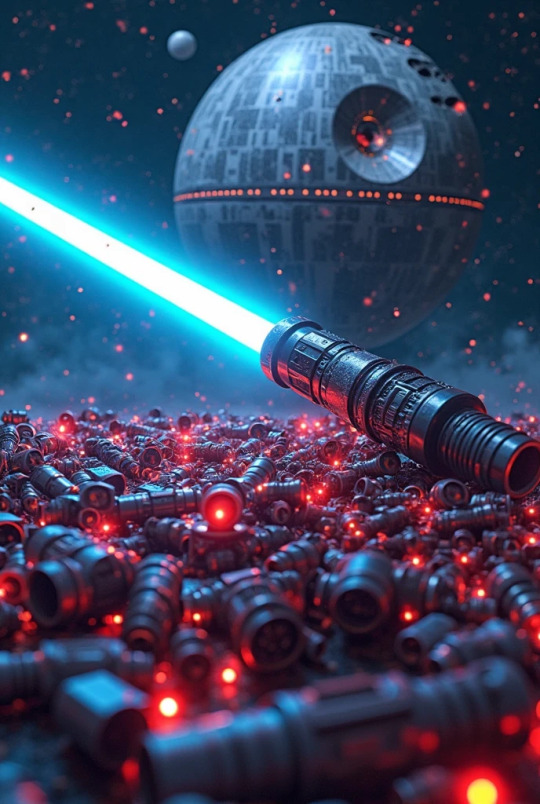
Chapter 1: The Force Awakens
The B4B-XH-A is no mere droid scrap. Crafted in the Temples of JST, it wields three tenets of the Force:
Jedi Precision: 2.5mm pitch, sharper than a vibroblade’s edge.
Wookiee Resilience: Survives -25°C Hoth winters and +85°C Mustafar meltdowns.
Droid Stealth: 9.8mm profile, slipping into astromechs quieter than a Bothan spy.
Why Imperial connectors fail:
Generic Clones: Clumsy as Stormtrooper armor, leaking energy like a faulty blaster.
Solder Cups: Overheat like Tatooine’s twin suns, warping circuits into Sith art.
Chapter 2: The Galactic Applications
1. Corellian Smart Homes: Powers Naboo-style automation hubs, defying Darth Vader’s glare with HA-standard compliance. “The Force is strong with this thermostat.”
2. Kamino Medical Labs: Sustains bacta tank monitors, sleek as a Kaminoan’s design. “Clunky tech? That’s a Sith lie.”
3. TIE Fighter Electronics: Endures engine heat storms, shielding backup systems from Kylo Ren’s tantrums.
4. Bespin IoT Arrays: Conducts sensor data through Cloud City’s turbulence, unphased by Lando’s smooth talk.
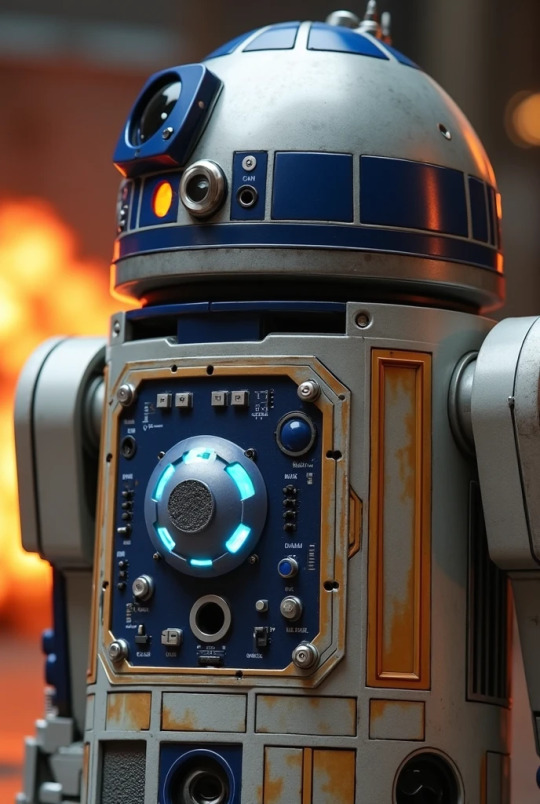
The Jedi Archives
Power Output: 3A current – fuels astromechs without draining the Millennium Falcon’s core.
Insulation Resistance: 1,000 MΩ, blocking leaks like a Force shield.
RoHS2 Compliance: Greener than Yoda’s swamp, pleasing the Galactic Senate.
The Sith’s Weakness
Imperial 2.54mm Clones: Bulkier than Jabba’s sail barge, failing under pressure.
Thermal Stress: Melts lesser connectors like a Death Star blast.
The Clone Wars of Reliability
B4B-XH-A:
Lifespan: Outlasts three Death Star rebuilds.
Voltage Withstand: 1,000VAC – shrugs off Emperor’s lightning.
Generic Tech:
Durability: Crumbles like a droid on Geonosis.
Cool Factor: As absent as Gungan diplomacy.
The Future: A New Hope
1. Hyperspace AI Integration: Self-diagnosing connectors for Coruscant’s smart factories. “The Force is my co-pilot.”
2. Outer Rim Space Tech: Radiation-hardened models for Jedi Temple Mars colonies.
3. Meme Galaxy: “How it feels to use B4B-XH-A” + Grogu wielding a soldering iron.
Epilogue: May the Connection Be With You To scorn the B4B-XH-A is to court the Dark Side—a realm of fried circuits and Sith-sparked failures. Choose wisely, young Padawan.
References:
JST Order 66 Survivors’ Manual (Jedi Engineering Archives)
Galactic RoHS Standards (Senate Decree 1138)
1 note
·
View note
Text
Innovative Solutions in Hydraulic Filtration Tanks: Advancing Efficiency and Durability

Hydraulic filtration tanks play a pivotal role in ensuring the optimal performance and longevity of hydraulic systems across industries. These systems, commonly found in construction, manufacturing, agriculture, and automotive applications, rely on clean, contaminant-free hydraulic fluid to function efficiently. The hydraulic filtration tank acts as the backbone of this process, filtering debris, moisture, and other contaminants that can compromise system performance. Check their site to know more details hydraulic filtration tanks
Understanding Hydraulic Filtration Tanks
At their core, hydraulic filtration tanks are designed to house and maintain filters that clean hydraulic fluids. They come in various shapes, sizes, and configurations depending on the application and system requirements. The tanks not only store hydraulic fluid but also provide a pathway for it to pass through high-performance filters.
Hydraulic fluid contamination is one of the leading causes of system failure, often resulting in equipment downtime, costly repairs, and reduced operational efficiency. The filtration tank ensures the hydraulic fluid remains clean by trapping particles, preventing corrosion, and minimizing wear and tear on critical components.
Key Components of Hydraulic Filtration Tanks
Filter Media: The heart of the filtration tank, responsible for capturing contaminants. Advanced filter media, such as microglass fibers and multi-layered synthetic materials, offer superior performance and durability.
Tank Reservoir: Holds the hydraulic fluid and allows proper circulation through the system. Reservoirs are often designed with baffles or flow control mechanisms to prevent turbulence and ensure uniform filtration.
Pressure Indicators and Sensors: Modern tanks are equipped with sensors that monitor fluid pressure and contamination levels, alerting operators when maintenance or filter replacement is required.
Valves and Connections: Properly designed inlet and outlet valves ensure smooth fluid transfer and seamless integration into hydraulic systems.
Technological Advancements in Hydraulic Filtration Tanks
The evolution of hydraulic filtration tanks has been driven by the need for enhanced efficiency, reduced downtime, and better adaptability to challenging environments.
Smart Filtration Systems: Integration of IoT-enabled sensors and real-time monitoring has revolutionized hydraulic filtration tanks. These systems provide data on fluid cleanliness, pressure levels, and operational health, allowing predictive maintenance and reducing unexpected failures.
Eco-Friendly Designs: Manufacturers are increasingly adopting sustainable materials and designs that minimize waste. Reusable filter elements and recyclable tank components are gaining popularity.
Compact and Modular Tanks: As hydraulic systems become more compact, so too have filtration tanks. Modular designs allow for easier customization and installation in space-constrained environments.
Applications Across Industries
Hydraulic filtration tanks are indispensable in industries such as:
Construction: Ensuring the smooth operation of heavy equipment like excavators and loaders.
Agriculture: Maintaining hydraulic systems in tractors and harvesters.
Manufacturing: Supporting automation and robotic systems with precise fluid control.
Best Practices for Maintenance
To maximize the performance of hydraulic filtration tanks, regular maintenance is crucial:
Monitor Filter Condition: Replace filters as needed to prevent clogging and fluid contamination.
Check Fluid Levels: Ensure the reservoir is adequately filled with the recommended hydraulic fluid.
Inspect for Leaks: Regularly check seals and connections for signs of leakage.
Conclusion
Hydraulic filtration tanks are critical to the efficiency and reliability of hydraulic systems. As technology advances, these tanks are becoming smarter, more durable, and eco-friendlier. For industries reliant on hydraulic machinery, investing in high-quality filtration tanks and adhering to maintenance best practices ensures smoother operations and cost savings in the long run.
#hydraulic valves#hydraulic pumps#hydraulic motors#hydraulic filtration tanks#hydraulic parts#hydraulic control#hydraulic drive technology#hydraulic systems#hydraulic spare parts#Low speed high torque hydraulic motor
2 notes
·
View notes
Text
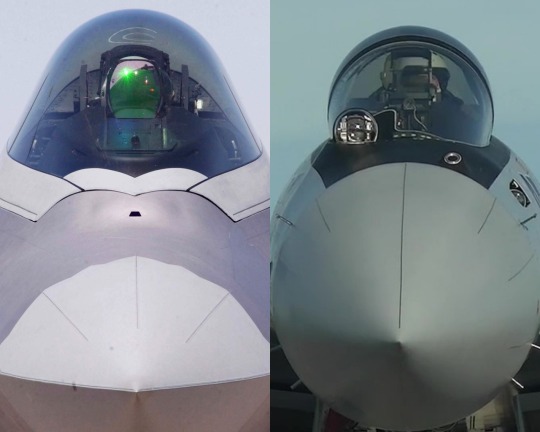
Does the absence of IRST leave the Raptor at a disadvantage compared to the Su-35?
Fernando Valduga By Fernando Valduga 01/31/2024 - 23:26in Military
Many military experts and former combat pilots often argue that the F-22 Raptor is currently considered unbeatable in relation to any other existing fighter, surpassing even the F-35 Lightning II in several aspects. But the Russian Su-35, even though it is not as powerful as the F-22 Raptor, it has an asset that could potentially challenge the supremacy of the Raptor.
Despite the impressive skills of the Lockheed Martin F-22 Raptor, there are still unanswered questions. Why does it lack essential features, such as the Infrared Search and Tracking (IRST) system and radars mounted on the sides? A need for expenditure containment by the U.S. Air Force, set at $9 million per aircraft in 1989, may have contributed to this omission.
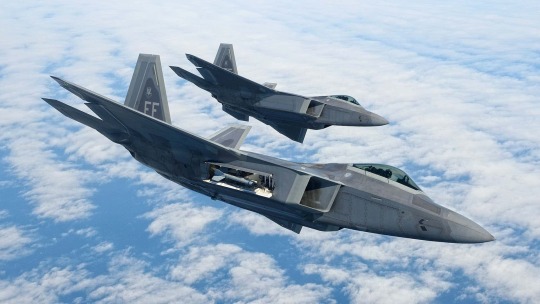
During this period, an initial project incorporated advanced US$ 16 million in avionics per aircraft. However, the U.S. Air Force did not specify which systems to eliminate to meet budget restrictions. This crucial decision was largely left to the manufacturers. As a result, Lockheed Martin chose to renounce certain features, including the IRST and side radars mounted on the sides below the cockpit.
After almost 33 years, USAF said in 2022 that it aims to find an infrared search and tracking (IRST) system for the F-22. An IRST would have to be integrated with the other sensors of the F-22 - mainly its active electronic array radar (AESA) to provide a holistic view of the battle space.
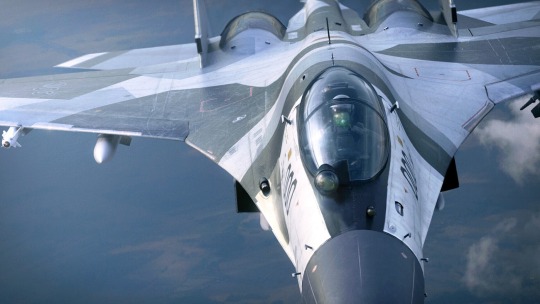
The strength of the fourth-generation Su-35 lies in its weapons control system by infrared search and tracking. This system includes a camera, target designator, laser rangefinder and an infrared sensor.
Although the fifth-generation F-22 and fourth-generation Su-35 seem equivalent in terms of capabilities, the Su-35 may have an advantage due to its air combat skills, its significantly lower price and its innovative IRST technology. These factors give the Russian fighter an advantage over its American equivalent.

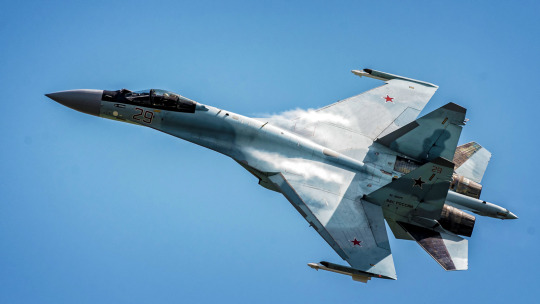
A study led by defense expert Alex Lockie points out that the Su-35s can actually have more advantages than the U.S. Raptors in direct combat or during interception missions. If an air combat occurs during an interception operation, it is believed that Russian fighters could have a significant advantage in detecting the supposedly "invisible" F-22 Raptor.
Expressing his professional opinion, Lieutenant Colonel David Berke, who has the rare experience of piloting both the F-22 and the F-35, suggested that if he were piloting the F-22, he would not opt for a maneuverable combat with an opponent. Instead, Berke would take advantage of the main force of the F-22 - its stealth capabilities - to avoid visual aerial battles.

Based on his knowledge of combat air power, expert Justin Bronk stated that aircraft models such as the F-22, characterized by their stealth design and internal weapon storage, may not be the preferred options for interception missions. Bronk pointed out that more cost-efficient jets can effectively play this role.
The Infrared Search and Tracking (IRST) system is used in fighters to detect and monitor objects that emit infrared radiation, such as other aircraft or missiles.
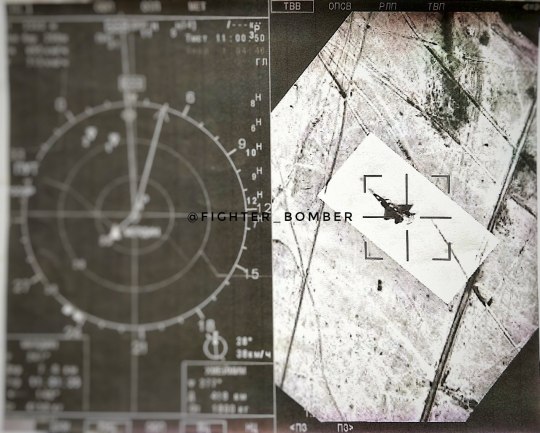
An F-22 seen by the Su-35's IRST sensor.
This technology operates as a passive sensor system, that is, it does not emit signals. Instead, it detects infrared radiation emitted by other objects. This is particularly advantageous in situations where the radar can fail, such as in stealth operations or environments with high electronic noise.
The last U.S. fighter to have an integrated IRST sensor during development was the F-14 Tomcat. The F/A-18 Super Hornet now has the option of carrying a central droptank with an IRST, which will make the combat launch expensive.
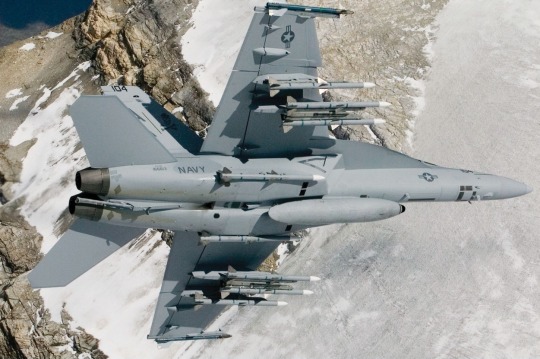
The IRST21 installed in the central tank of a Super Hornet.
The operation of an IRST system involves several steps. First, the system scans the environment for infrared radiation sources, usually using a rotating mirror that reflects the radiation received in an infrared detector. This detector converts infrared radiation into an electrical signal, which is processed by a computer to form an image.
Subsequently, the system analyzes this image to identify potential targets based on their distinct thermal signatures. This operational process can be performed several times per second, allowing the system to accurately track mobile targets.

An aircraft equipped with an IRST system has several advantages. First of all, because it is passive, this system does not reveal the location of the aircraft as the radar does, making it ideal for stealth operations.
Secondly, IRST systems can detect targets at long distances, even under conditions where the radar may prove ineffective, such as under heavy rain or through smoke. Thirdly, IRST systems can detect stealth aircraft, specifically designed to be undetectable by radar.

FAB F-39E Gripen fighter equipped with the IRST.
Finally, since IRST systems use thermal signatures to identify targets, they are less likely to be deceived by baits or other countermeasures that could potentially deceive radar systems.
Tags: Military AviationF-22 RaptorIRSTSu-35 Flanker
Sharing
tweet
Fernando Valduga
Fernando Valduga
Aviation photographer and pilot since 1992, he has participated in several events and air operations, such as Cruzex, AirVenture, Dayton Airshow and FIDAE. He has works published in specialized aviation magazines in Brazil and abroad. He uses Canon equipment during his photographic work in the world of aviation.
Related news
MILITARY
Taking advantage of the Red Flag, USAF performs the first "Bamboo Eagle" Exercise by adding multi-domain elements
31/01/2024 - 17:00
MILITARY
Russia's large stealth attack drone, Okhotnik, is expected to go into mass production in 2024
31/01/2024 - 16:00
Beta Technologies' Alia electric aircraft completed a three-month experimental deployment with the U.S. Air Force that included a simulated evacuation of victims at Moody Air Base, Georgia. (Photo: U.S. Air Force / Samuel King Jr.)
MILITARY
USAF: Electric aircraft Alia performs evacuation simulation of victims at a cost of only 5 dollars
31/01/2024 - 14:00
MILITARY
Ukraine claims to have shot down another Russian Su-34 combat jet
31/01/2024 - 11:30
MILITARY
Acquisition of F-35, A400M and helicopters are part of Germany's budget of 34.9 billion euros for 2024
31/01/2024 - 08:44
AERONAUTICAL ACCIDENTS
USAF F-16 accident in South Korea
30/01/2024 - 23:17
10 notes
·
View notes
Text
The Resolution of Water for Every Home is Becoming a Reality: Rajvardhan Rathore’s Vision for a Sustainable Future

In recent years, one of the most pressing global challenges has been water scarcity. With climate change affecting the natural water cycle and the growing demand for fresh water due to rapid urbanization and population growth, water conservation has become more crucial than ever. In India, where many areas face chronic water shortages, the call for a sustainable solution has been growing louder. Amid these challenges, former Union Minister and current Member of Parliament, Rajvardhan Singh Rathore, has emerged as a champion for water conservation and a strong advocate for ensuring that every household has access to clean, reliable water. His vision for a water-secure India is now turning into reality, offering hope to millions across the country.
The Vision: Water for Every Home
Rajvardhan Rathore, known for his distinguished career in sports, politics, and social activism, is now focusing his energy on resolving one of the country’s most critical issues: water scarcity. His initiative aims to ensure that water is no longer a distant hope for people in rural and urban areas alike. Rathore’s approach is rooted in the belief that every home in India should have access to clean, potable water, regardless of geographical location or economic status.
He has been actively involved in raising awareness and garnering support for sustainable water management practices, advocating for the use of technology, government policies, and community-driven solutions. Under his leadership, several programs have been designed to transform the water landscape in India, making water security a tangible reality for the masses.
Empowering Communities and Leveraging Technology
Rathore’s vision is not just about ensuring water availability but also about changing the way we think about water conservation and management. The core principles of his initiative are:
Rainwater Harvesting and Conservation: One of the primary strategies promoted by Rathore is the implementation of rainwater harvesting systems across homes and communities. This technique, which captures and stores rainwater for future use, can significantly reduce dependence on external water sources. Encouraging rainwater harvesting in both urban and rural areas is an affordable and effective solution to tackle water shortages.
Revitalizing Traditional Water Bodies: India has a rich history of traditional water management systems such as stepwells, ponds, and tanks. Rathore’s initiative involves reviving these age-old methods to enhance local water retention capabilities. Restoring and maintaining these natural water bodies can not only ensure a sustainable water supply but also help restore ecological balance in rural and semi-urban areas.
Technological Solutions for Water Distribution: Recognizing the importance of technology, Rathore advocates for the use of smart water management systems, which can optimize water distribution and reduce wastage. Internet of Things (IoT) sensors, data analytics, and automated irrigation systems are being implemented in various regions to monitor and manage water usage efficiently. With digital tools, it’s possible to track water flow, detect leaks, and predict future water demand.
Public Awareness and Education: Rathore’s initiative emphasizes the importance of education and awareness campaigns. By teaching communities about water conservation techniques, efficient usage practices, and the importance of protecting water bodies, Rathore aims to foster a culture of responsibility toward this precious resource. Public engagement through workshops, media campaigns, and community-driven projects are integral to ensuring that water management becomes a collective goal.
Policy Advocacy and Government Support: Rathore is also advocating for stronger government policies to ensure equitable access to water for all. His efforts have led to collaborations with policymakers, local authorities, and private organizations to create frameworks that enable large-scale implementation of water security projects. These policies encourage both government and private sector investment in water infrastructure and conservation efforts.
Realizing the Dream: Achievements and Impact
Under Rajvardhan Rathore’s leadership, several states in India have already started seeing improvements in their water management systems. From the revival of ancient water harvesting systems in Rajasthan to the implementation of smart irrigation technologies in Punjab, Rathore’s vision is being brought to life in various parts of the country.
His work has also influenced the development of the “Jal Jeevan Mission,” a government initiative aimed at providing safe and adequate drinking water to every rural household in India by 2024. By aligning his initiatives with national water goals, Rathore is playing a key role in shaping policies that work toward long-term solutions.
Overcoming Challenges
Despite the momentum generated by Rathore’s efforts, significant challenges remain in achieving water security for all. These include inadequate infrastructure in many rural areas, lack of political will in some states, and the resistance to change among certain sections of the population. Moreover, the impacts of climate change, such as erratic rainfall patterns and rising temperatures, present additional obstacles.
However, Rathore’s approach emphasizes the importance of resilience. He believes that by building sustainable systems, educating communities, and fostering collaboration among stakeholders, these challenges can be overcome. His focus on local solutions, paired with national efforts, is gradually paving the way for a water-secure future.
The Road Ahead
The vision of “Water for Every Home” is one that resonates deeply with the people of India, especially in rural regions where access to clean water is still a challenge. Rajvardhan Rathore’s unwavering commitment to solving this issue, combined with his leadership and collaborative approach, is turning this vision into a reality.
As India continues to face the pressures of population growth, urbanization, and climate change, initiatives like Rathore’s are crucial in ensuring that future generations inherit a world where water is abundant, clean, and accessible for everyone. The work being done today sets the foundation for a more sustainable and equitable future, where every home has the water it needs to thrive.
Rajvardhan Rathore’s efforts are proof that with dedication, innovation, and collaboration, even the most daunting challenges can be tackled — one drop at a time.
3 notes
·
View notes
Text
About Hydrowverse
HydrowVerse, founded by Thomas David Tency and Dr. Sachin Chaudhari at IIIT Hyderabad, is dedicated to revolutionizing water resource management with innovative, non-intrusive technology. Our research-based startup provides comprehensive water intelligence solutions, focusing on seamless and efficient monitoring of tanks, borewells, water meters, and rivers without direct contact. We empower individuals and organizations with insights to manage water sustainably, inviting you to join our journey towards smarter water management.
Mission
Optimize water infrastructure operations while transforming it into a smarter, more efficient system. Enhance water management education to foster knowledge and innovation.
Vision
Our vision is to establish ourselves as a prominent brand in the field of water intelligence, providing comprehensive and end-to-end solutions for all facets of water management. We are committed to integrating Internet of Things (IoT) and artificial intelligence (AI) technologies to develop innovative monitoring and management tools. Additionally, we will offer educational services that empower stakeholders at all levels to make informed decisions regarding water resources.
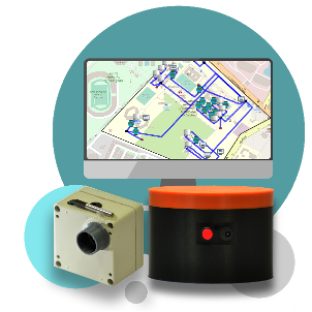
HydrowVerse innovates water management with Starr, an IoT-enabled device that accurately estimates water levels in overhead and underground tanks up to 5 meters deep. Starr ensures safety and reliability by avoiding sensor contact with water. Real-time updates help organizations track water levels, prevent overflows, and manage resources effectively. Built-in tank leakage detection enables proactive maintenance to minimize water loss. Starr enhances WaterAid’s water storage and distribution efforts, leading to smarter, data-driven management for a sustainable future. Together, we ensure every drop is measured and conserved.
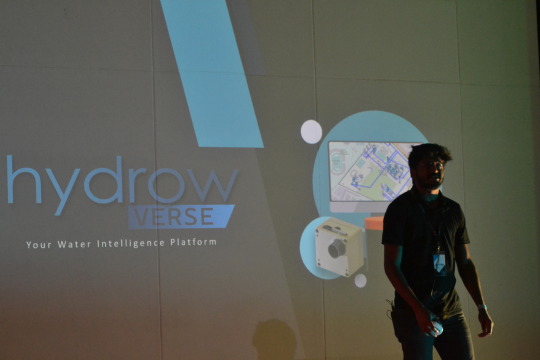
Our real-time dashboard is meticulously designed to provide a comprehensive overview of water resource management by integrating data from all connected devices into a user-friendly interface. This centralized platform presents key metrics and performance indicators, enabling users to monitor water usage, identify anomalies, and discern trends at a glance.
In addition to real-time data visualization, our dashboard incorporates predictive maintenance tools that analyze historical data to forecast potential issues before they escalate. This proactive approach facilitates timely interventions, minimizing downtime and associated maintenance costs.
Furthermore, the dashboard encompasses water pressure estimation capabilities, offering critical insights into system performance and ensuring optimal water distribution.
Collectively, these features empower users to make informed decisions, optimize operational efficiency, and safeguard the integrity of their water infrastructure.
Our solutions are easily adopted, seamlessly integrating with organizations of all sizes. They’re cost-effective, reducing water loss and operational costs. Real-time updates allow users to monitor water resources and address issues promptly. Our technology is scalable, growing with your needs and maintaining optimal efficiency as your infrastructure expands.
#smart meters#water tech#hydrowverse#Thomas David tency#Retrofit#Non intrusive tech#analog water meters#AI#ML#Water intelligence#leakage detection#Water Monitoring
2 notes
·
View notes
Note
In the far future, you have your own personal robotic companion! And let's just say, you've made particular modifications to it~ Nothing so relaxing as coming home after work, stripping down, and crawling inside your robot for a nap inside its padded synthetic belly with calming music/asmr playing, temperature control, a soothing belly massage routine; like a mobile sensory deprivation tank, as it goes about house chores with you inside~
These robot companions are amazing! Their base model is for helping around the house but you are able to add on mods that can change them to your specifications. To my excitement I'm able to add in a special compartment in their "stomach" panel that are able to work as a womb of sorts. It has special settings as well that make it even more comfortable whenever I need some time away from the world.
My robot has the plush body, expandable "womb", extra womb padding, noise machine, health metrics monitor, and temperature regulation. It's the perfect place to hang out in my opinion. My sweet robot seems to have a ball carrying me around any time I need to forget about my life to hide away. I always feel their hands rubbing around their belly, eager to feel how their body has changed and check on how I'm doing. Sometimes I wonder if there is something extra with the robot since they seem to really enjoy carrying me around.
With all the monitors and sensors they know when I need to eat, drink, and get out to use the bathroom. It is a bit complicated while "in utero"—there are two panels, one for the womb and the second for the stomach, that have to opened in order for anything to comd in or out. Or when it's packaged snacks and bottled/canned drinks my robot swallows them and they are brought straight into the womb. What's really strange is when I get hungry the robot automatically has a stomach growling noise to alert them of my hunger. They're attuned to my body's needs. It was weird when they originally had to integrate with me (strange futuristic technology that I still can't understand) but now I don't forget to take care of myself. Someone else does it for me!
My favorite part about the womb is how I could make it feel as if I were really in a womb. I keep myself at a perfectly warm temperature that is pleasantly comfortable, being lulled to sleep more than I'll readily admit. The ambient noises are interesting as well. With the long list of options I often find myself picking the heart beat because it is the most soothing sound. The womb even pulsates as if there was a heart pumping blood throughout the body. Sometimes I add on a breathing noise that makes my stays even more peaceful. It takes a too much coaxing from my robot for me to leave when I am too stubborn to leave. They always promise me that there's always tomorrow to hideaway in their womb. It's addictive to be huddled away in my robot.
I don't ever want to leave. I'm not really sure that my robot wants me to either.
#;you have questions? i have answers!#baby boy 💕#extreme cuddling#robot safe vore#let-me-fill-you#;this took me much too long to write i am so sorry#;but i would probably never leave my robot if i had one#;being in a super soft warm place where someone takes care of me the whole time? a perfect place to exist#;though my robot gets really into their belly.....do they have an ulterior motive?
12 notes
·
View notes
Text
The Importance of Industrial Inspection Services in Modern Manufacturing
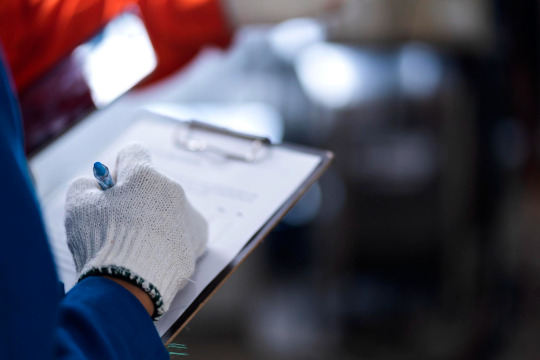
Industrial inspection services play a crucial role in ensuring quality, safety, and compliance in modern manufacturing. With the rising demand for precision and efficiency, manufacturers must adopt stringent inspection protocols to maintain high standards. Whether it’s tank inspection services, pressure vessel inspection services, or manufacturing quality control, industrial inspection services help identify potential issues before they become costly problems.
Why Industrial Inspection Services Matter
The importance of industrial inspection cannot be overstated. It ensures that equipment and machinery function correctly, products meet safety standards, and facilities comply with regulations. Industrial inspection services also help manufacturers maintain a competitive edge by minimizing downtime, reducing errors, and improving overall productivity. Without proper inspection, companies risk equipment failures, safety hazards, and potential legal issues.
Key Industrial Inspection Techniques
Various industrial inspection techniques are employed to ensure efficiency and safety. Some of the most common methods include:
Non-Destructive Testing (NDT): This technique helps in detecting flaws or inconsistencies in materials without causing damage. It is widely used for tank integrity inspection services and vessel inspection services.
Vessel Crack Test Inspection Services: Identifies structural weaknesses in storage tanks and vessels, preventing potential failures.
Tank & Vessel Crack Detection: A crucial process in pressure tank inspection to ensure that tanks can withstand operational pressures.
Manufacturing Process Inspection: Involves monitoring different stages of production to detect defects early.
Factory Inspection Services: Covers a wide range of evaluations, including equipment condition, process efficiency, and compliance with industry standards.
The Role of Industrial Inspection in Manufacturing Quality Control
Quality assurance in manufacturing is impossible without thorough inspections. A well-executed manufacturing compliance inspection service helps businesses meet regulatory requirements and enhances customer satisfaction. Companies investing in professional quality control services and certified industrial inspectors ensure that their products and equipment adhere to the highest safety and quality standards.
For industries dealing with hazardous materials, industrial safety inspection is essential to prevent accidents. Regular equipment inspection in industries reduces risks associated with wear and tear, corrosion, and operational inefficiencies.
Tank and Vessel Inspections: Ensuring Safety and Compliance
Storage tanks and pressure vessels are vital in industries such as oil and gas, chemicals, and pharmaceuticals. Ensuring their structural integrity requires storage tank inspection, storage vessel inspection, and pressure vessel inspection services.
A reputable tank inspection company provides:
Tank Integrity Testing Services: Evaluates tank conditions to prevent leaks and contamination.
Tanks Inspection & Engineering Services: Comprehensive evaluation of tank design, installation, and performance.
Vessel Inspection Solutions: Helps industries maintain compliance and prevent operational failures.
Third-Party Industrial Inspection Company Services: Ensures unbiased assessments and quality control checks.
Choosing the Best Industrial Inspection Services
To get the most out of industrial inspection services, manufacturers must collaborate with trusted industrial inspection service providers. When selecting an inspection partner, look for:
Experience and Expertise: Opt for industrial quality assurance experts with a track record of excellence.
Certifications: Ensure that the inspectors are certified professionals.
Comprehensive Solutions: The provider should offer a range of services, including affordable factory inspection solutions and hire manufacturing inspection experts.
Conclusion
In the fast-paced world of manufacturing, industrial inspection services are essential for maintaining high standards of quality and safety. From pressure vessel inspection services to manufacturing compliance inspection services, regular inspections help prevent costly breakdowns, improve efficiency, and ensure regulatory compliance. By working with an experienced industrial inspection company, businesses can safeguard their operations and maintain a competitive edge in the market.
For expert industrial inspection services, trust Bioscan LTD to deliver reliable and professional quality control solutions tailored to your needs.
#IndustrialInspectionServices#ManufacturingQualityControl#TankInspectionServices#NonDestructiveTesting#QualityAssurance
1 note
·
View note